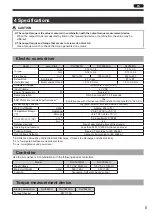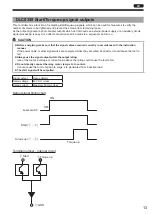
15
EN
Symptoms
Location to investigate
Solution
The output torque is
high.
Screws are tightened too
much.
Did you check the correlation between
the output torque occurred on screws
and the output torque measured using
a measurement device?
The output torque occurred on screws and the
output torque measured by the measurement device
are different.
Adjust the output torque according to the screw
fastening conditions. (p. 5)
Have you attached a heavy jig or a jig
having a large radius at the end?
After the torque reaches the set torque, the inertial
force of the jig might have been transmitted to
screws.
Review the jig and reduce the weight or size of the
jig.
The torque scale and
output torque do not
match.
The torque scale is a standard. The output torque range is not guaranteed.
The output torque range sometimes differs from the scale but this is not a product error.
(p. 6)
The electric screwdriver
gets hot.
Is the ON time of the electric
screwdriver too long?
Alternatively, is the OFF time too
short?
Review the operation time.
The rated operating time is 0.5 sec. ON and 3.5 sec.
OFF.
Aim at 15 screws per minute. (p. 5)
Even though the output torque is set
to the specification lower limit value,
does the screwdriver get hot to a level
where you cannot touch it?
When the output torque becomes higher, the electric
screwdriver becomes hot.
If it gets hot to a level where you cannot touch even
with the specification lower limit value, a failure is
suspected.
The rotation speed is not
stabilized.
Is the electric screwdriver heating up?
Is it the same electric screwdriver?
The specification value of the rotation speed is a
standard.
The rotation speed could change due to
temperature or mechanical loss of the main unit
or grease conditions. Also, it differs by the unit.
(p. 5)
Maintenance and inspection
WARNING
Before performing maintenance and inspection, always turn off the power.
Do not disassemble or alter the tool.
Use genuine parts.
CAUTION
For repair or part replacement, ask your dealer.
Repair requires special knowledge and skills. If repair is performed at a place other than a specialty store, the
tool may not demonstrate its full performance or it could lead to an accident or injury.
Request repair with the failed status kept intact.
When requesting a repair, do not throw away damaged parts. It could be important information for investigating
the failure cause so do not change the status.
For the purpose of making proper use, request the following check and maintenance by an authorized service facility.
Routine inspections and parts to be replaced
Number of tightening (million)
0.25
0.5
0.75
1.0
Routine inspection
(1) Operation check
(2) Grease-up
Parts to be replaced
(1) Motor assembly
(2) Gear
(3) Rollers and Balls
(4) Bearing
TV06941-2̲DLV5800̲en.indb 15
TV06941-2̲DLV5800̲en.indb 15
2019/08/19 11:04:22
2019/08/19 11:04:22

















